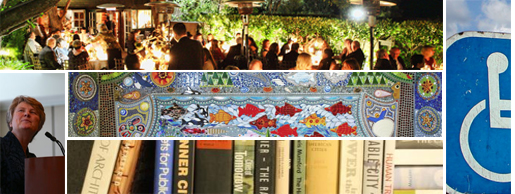HDR on art-filled spaces. P+W discusses disabilities and design. Summer reading with SPUR Rugged history from Preservation. Nature's mutualism.

Art filled spaces. Michael McManus, communications specialist at HDR Architecture, writes about the new HDR expansion of MultiCare Health System’s Mary Bridge Children’s Hospital and Health Center in Tacoma, WA,
For the art program, designers from HDR and Bainbridge worked with the client, an art committee, and an art broker to commission works of art by local Tacoma artists. “The artists were tasked with creating pieces that reflect Washington’s Puget Sound. The Puget Sound, which is an inlet of the Pacific Ocean, is home to a wealth of coastal life, from the giant pacific octopus to curious seals and an abundance of Orcas. Each piece that was placed in the hospital captures the innate wonder of marine life.” – Michael McManus
Disabilities and design. Bill Schmalz and Bruce Toman of Perkins + Will, examine accommodations for those with physical disabilities and how this affects design.
For those who aren’t disabled, the temporarily-able bodied, “we don’t know when accessible design will help us, but at some point in our lives, it probably will.
That’s the attitude we should take when we design. Rather than reluctantly complying with codes and standards, or charitably giving “those disabled people” a break, let’s take the selfish approach: we’re designing accessible spaces for ourselves” – Bill Schmalz and Bruce Toman
Favorite urbanism reads. SPUR, an organization that’s dedicated to ideas and action for a better city, provides a summer reading list of its favorite books on urban planning and policy.
Jeff Speck’s Walkable City: How Downtown Can Save America One Step at a Time, will be discussed during SPUR Reads, a book discussion series launching in San Jose this summer.
Via SPUR
Historic with rugged charm. Lauren Walser, field editor at Preservation magazine, discusses a visit to the historic restaurant Saddle Peak Lodge in Calabasas, California.
While the historic building has been a restaurant for many years, current owner Ann Graham Ehringer purchased it in the early 1990s and revived much of the interior. Her approach has been one dedicated to continual maintenance, making repairs to the historic structure, ensuring the space always feels welcoming and has been a preservation steward of the property.
Biomimicry and urban design. Biomimicry 3.8 hosted the 7th Annual Biomimicry Education Summit and first Global Conference in Boston this past weekend, keynoted by Biomimicry 3.8 cofounder Janine Beynus.
Benyus proposed a shift in thinking about how nature's communities function, arguing that mutualism, not competition, is the driving force in nature. "Together is better," she said, adding that building mutually beneficial relationships will ultimately result in surplus, not scarcity.
Via Treehugger
